ARISSat-1 is a microsat developed as a follow-on to the SuitSat-1 project. The satellite was launched to the ISS on January 28th, 2011, with deployment into space during an EVA (spacewalk) on February 16, 2011. The satellite will downlink live SSTV images from four onboard cameras as well as 24 greetings in 15 languages on the FM voice frequency 145.95 MHz. The BPSK-1000 sig downlinks as SSB on 145.920 MHz, with the CW signal below the BPSK signal to be used as a tuning indicator for the BPSK signal. Telemetry and amateur radio callsigns of those instrumental in amatuer radio in space will be transmitted at 145.919 MHz.
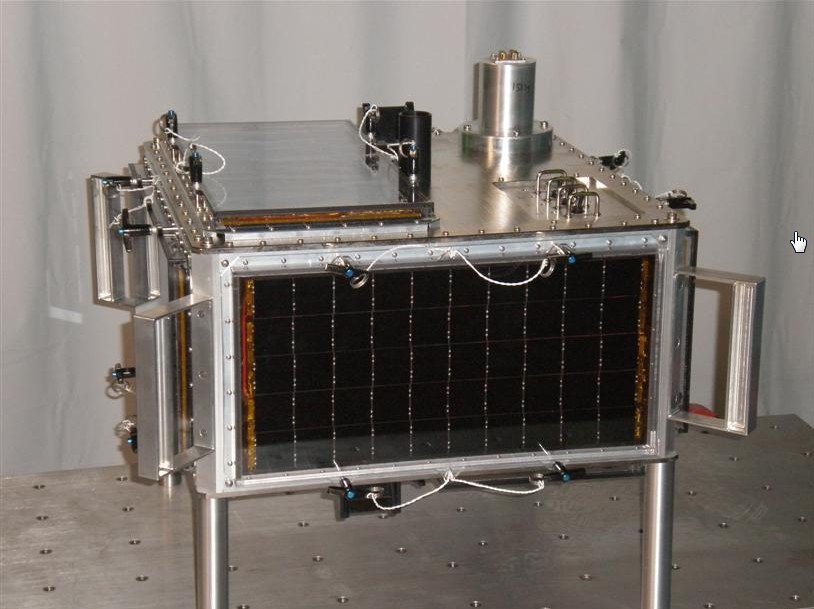
For the amateur radio operators there is a 16kHz wide transponder for two-way contacts. All of the transmissions and receicvers use newly created software defined radio technology. The BPSK-1000 signal will include alternating telemetry and experiment data packets. Telemetry data will include spacecraft subsystem information such as temperature, voltage and current measurements. The Kursk State University experiment will be sent as 5 packets for a total of 2k of data. The data is collected for 90 each day. This experiment will sample the change in vacuum as the satellite slowly re-enters the atmosphere.
NASA-Catalog: 37772
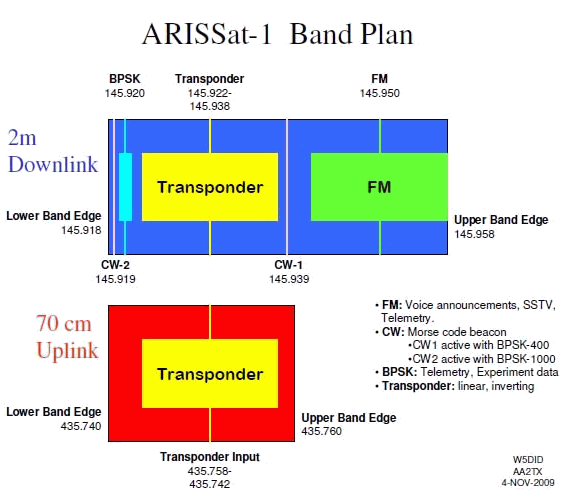
Downlink
Mode V FM (Voices Messages and Telemetry):
145.9500 MHz FM
Mode V FM Imaging (Robot-36 SSTV from onboard cameras):
145.9500 MHz FM
Mode V SSB Telemetry (BPSK-1000 bps):
145.9200 MHz BPSK
Mode V SSB TLM Beacon (CW-2, active with BPSK-1000):
145.9190 MHz CW
Mode U/V (B) Linear Transponder (Inverting)
Uplink: 435.7580 – 435.7420 MHz SSB/CW
Downlink: 145.9220 – 145.9380 MHz SSB/CW
Call
RS01S
Status
ARISSat-1 ist am 04.01.2012 ca. 07:00 UTC +/- 3h beim Wiedereintritt in die Erdatmosphäre verglüht.
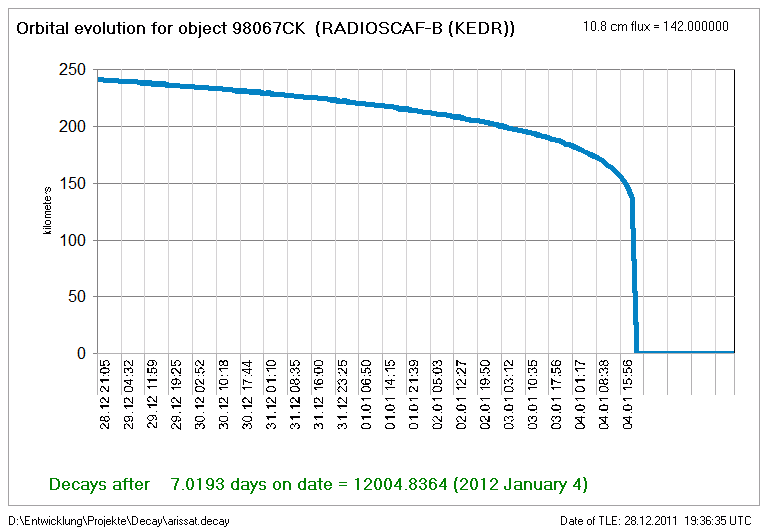
CW-Bake
Die CW Bake besteht neben den verschiedenen Rufzeichen aus einem Zeitstempel (MET = Mission Elapsed Time ), Temperaturwerten der Internal Housekeeping Unit (IHU) und des Control Panel (CP), Batteriespannung und -ströme. Das CW Signal befindet sich 500 Hz unter dem BPSK Signal und dient der Dekodersoftware als Referenzsignal.
hi this is arissat1 rs01s ct1zx phi met 27m ihu +41c cp +29c bat 35.89v -16ma rf 465ma hi this is arissat1 rs01s dj4zc phi met 28m ihu +42c cp +29c bat 35.77v -12ma rf 499ma hi this is arissat1 rs01s f6bvp phi met 30m ihu +43c cp +30c bat 35.93v -16ma rf 339ma hi this is arissat1 rs01s g3ior phi met 31m ihu +43c cp +30c bat 35.69v -12ma rf 434ma hi this is arissat1 rs01s g3vzv phi met 33m ihu +44c cp +30c bat 35.81v -16ma rf 508ma hi this is arissat1 rs01s g3yjo phi met 34m ihu +44c cp +31c bat 35.69v -20ma rf 389ma
Mehr als 200 Rufzeichen von Funkamateuren, die sich im Bereich Amateurfunksatelliten verdient gemacht haben sind fest programmiert. Aufgrund der defekten Batterie und dem damit verbundenen Reset in der Eklipse wird man die „hinteren“ Rufzeichen leider nie mehr kennenlernen. ARISSat CW und BPSK Signal
ARISSat CW und BPSK Signal
BPSK
Für die ARISSat-1 Telemetrieübertragung wurde eine neue FEC kodierte DBPSK (Differential Binary Phase Shift Keying) Modulation entwickelt. Eine „1″ wird dadurch übertragen, dass die Phasenlage um 180° gedreht wird, und eine binäre “0” indem der aktuellen Phasenlage eine von 0° hinzugefügt wird. Werden also zwei “Einsen” hintereinander übertragen, dann kann die erste die Phasenlage 0° haben, die zweite ist auf jeden Fall um 180° gedreht. Diese Modulation ist sehr robust und sehr unempfindlich gegen Fading. Gerade für Satelliten in einem niedrigen Orbit ohne Lagestabilisierung ist das sehr wichtig. Ein weiterer Pluspunkt ist, dass das CW Referenzsignal in einem 300 Hz breiten Fenster gesucht wird. Man benötigt also wirklich keine exakte Dopplerkorrektur in 10 Hz Schritten (wenn man sie hat – umso besser…), sondern manuelles Tuning reicht völlig aus.
Das ist übrigens auch ein Vorteil, wenn man das Signal mit dem FunCubeDongle empfängt. Man kann bequem die gesamte 40 KHz Bandbreite aufzeichnen und später in Ruhe die gesamte Telemetrie auswerten – CW und BPSK und auch die SSTV Bilder.
Die blau gestrichelte Linie folgt dem CW Signal, die orange Linie zeigt die Mitte des BPSK Signals an. Zur optimalen Dekodierung des BPSK Signals sollte die blaue Linie mit der gelben Linie deckungsgleich sein. Man muss also nur das CW Signal im USB Mode empfangen und auf die gelbe Linie abstimmen. Auf jeden Fall sollte man in der Dekodersoftware die Option „Forward telemetry“ aktivieren. Dadurch wird jedes empfangene Packet direkt an den ARISSAT Telemetrie Server gesendet. Weltweit wurden bisher mehr als 200.000 Telemetriepakete gesammelt.
Hier eine kleine Statistik [Stand 23.12.2011]
249 Stationen 128095 ARISSat-Telemetrie Datensätze 114479 KURSK Datensätze
SSTV
ARISSat trägt 4 Kameras an Bord, die über einen Spiegel ins All blicken. Ungefähr jede 2 Minute wird eine Aufnahme gemacht und im Speicher abgelegt. Leere oder sehr dunkle Bilder werden verworfen. Zudem gibt es 2 aufgezeichnete SSTV Bilder, die z.B. während den Eklipsen gesendet wurden. An der Farbe des Rufzeichens in der oberen linken Ecke erkennt man die Kamera und damit die Blickrichtung. Die Qualität der empfangenen Bilder ist sehr hoch und man kann sehr schöne Aufnahmen der Erde sehen.

rot = -Y Seite
grün = +Z Seite
blau = -Z Seite
magenta = +Y Seite ARISSat SSTV (Kamera -Z)
ARISSat SSTV (Kamera -Z) ARISSat SSTV (Kamera +Z)
ARISSat SSTV (Kamera +Z)

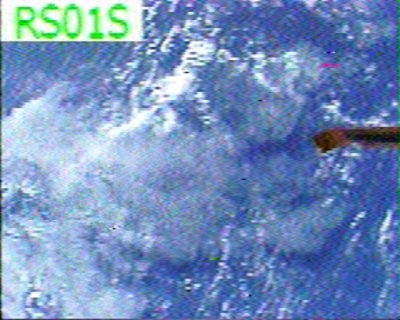
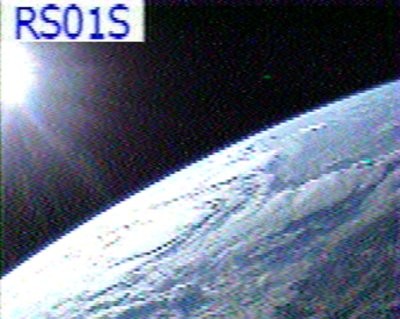
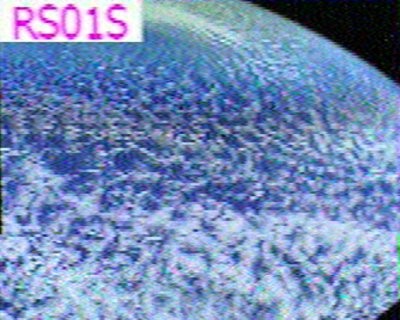

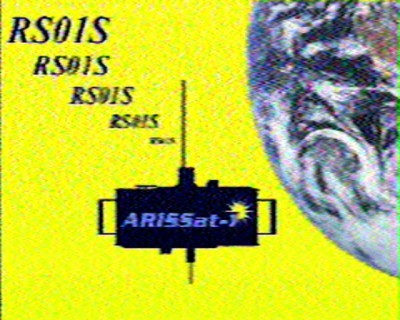
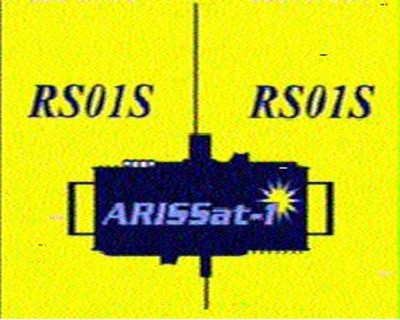
FM Übertragung
Das FM Signal besteht aus einer ID – „Hi, this is ARISSat-1 …“, Grußbotschaften, gesprochenen Telemetriewerten und dem SSTV Signal. Zyklisch werden 24 verschiedene Grußbotschaften in 15 Sprachen gesendet – und eine historische Aufnahme – Pojechali (Los geht’s). Mit diesen Worten soll der sowjetische Kosmonaut Juri Gagarin vor 50 Jahren am 12. April 1961 den ersten Flug eines Menschen ins All begonnen haben.
Am Ende der meisten Grußbotschaften gibt es ein “geheimes Wort”. Wer dieses Passwort empfängt, kann ein Zertifikat anfordern (Secret Word Contest)

 Hi this is ARISSat-1 RS01S
Hi this is ARISSat-1 RS01S gesprochende Telemetrie (weiblich)
gesprochende Telemetrie (weiblich) gesprochende Telemetrie (männlich)
gesprochende Telemetrie (männlich)
Internationale Grußbotschaften

Sekai no minasan kon_nichi wa. Boku-tachi, watasi-tachi wa Iruma-si jidou sentaa de musen ya tenmon no katsudou wo site imasu. Itsuno hi ka boku-tachi kodomo demo kokusai-utyuu-suteisyon ni ikeru hi wo, tanosimi ni siteimasu. Ai-kotoba wa ‘Kibou’ desu.
English translation: Hello, all of you of the world. We are doing activity of radio and astronomy in “Children center in Iruma-City. The day when even we child can go to International Space Station looks forward to coming sometime or other. The secret word is HOPE. [thanks Mineo san, JE9PEL] Bengali
Bengali

English translation: 2011 AD – marks 50 years since when the first human went into space. We give our best wishes to everyone who is listening to us on Radio Sputnik and RadioScaf-2. Sputnik has been launched from International space station. I wish for happyness and joy and a rebirth for society/civilization for all people in the mortal realm. Thank you. Password BENGALI. Belgien
Belgien
Hallo mijn klas 6ab wonen in Belgie. Beter gezegd: Belgie, met B van betoverend mooi, de E van erg klein is ons land, de L van Leuven. Daar is onze school, de G van gezellig, de I van in onze klas zitten we met drieentwintig, en de E van dit is het einde van onze boodschap. Groetjes uit Belgie. Het geheime woord is BOUWEN.”
English translation: Hello! My class is 6ab. We live in Belgium – Or as we call it : Belgie. B stands for enchantingly beautiful, E for a very small but easy-access country, L for Leuven, where our school is situated, G for cosy and gentle, I in our class there are 23 interesting people, E end of this message! Greetings from Belgium! The secret word is: BUILD.
[thanks Danny, ON5UE] China
China

English translation: 2011 is the 50th anniversary of the first manned flight into space, we are university students from different countries, welcome all the audience who are listening to our program now. A new small spacecraft — RadioSCAF-2 is now in space and orbiting the earth, this satellite was launched from the International Space Station during the EVA of cosmonauts in space. [thanks Edward, BX1AD] Belgium
Belgium
Wij zijn 6B uit De Haan. Samen kunnen wij alles aan. Blank of zwart. Maakt niet uit. Met ze’n allen rappen we luid. Wees altijd goed voor elkaar. En ons rappertje is nu klaar. Het geheime woord is CHOCOLADEFRIET.
English translation: We are 6B from De Haan, translated: The Cock. Together we are a very nice flock, Black or white, it doesn’t matter as long as you’re an inspired rapper, together we proclaim loudly, treat each other kindly. We hope this rap is very nice. The secret word is CHOCOLADEFRIES. [thanks Danny, ON5UE] Spanien 1
Spanien 1
En la tierra hay mucho odio y muchas guerras. El espacio es infinito y por el viajan las emisiones de todos los radioaficionados del mundo sin distinción de raza, credo o condición. Luchemos para que prevalezca esta visión de la humanidad más allá de los confines de nuestra galaxia. Desde España EB7DX. La palabra secreta es FRECUENCIA.
English translation: In the Earth there is so much hate and wars. The Space is infinite and for it travels the broadcasts of all hams around the world, regardless of race, creed or condition. Let’s fight to prevail this vision of the mankind beyond the ends of our galaxy. From Spain, EB7DX. The secret word is FREQUENCY. [thanks Fran, EA1JM] Südamerika (spanisch)
Südamerika (spanisch)
Año 2011 el Libertario 50 el primer vuelo tripulado sportimer. Somos estudiantes de diferentes países y saludamos a todos los que nos escuchen. Este satélite fue lanzado desde la estación espacial internacional durante la salida tripulada de los astronautas al espacio. Les deseamos a todos paz en la tierra y felicidad a cada uno de ustedes. Éxito en las realizaciones cósmicas en bien de la humanidad. Password: SPAM.
Translation into English: Year 2011, Liberty-50 the first tripulated flight sporttimer. We are students from different countries and we greet to all that listen us. This satellite was launched from the International Space Station during the programmed spacewalk of its astronauts. We wish you all peace on Earth and happiness for each one of you. Success in the cosmic missions for the good of the mankind. Password: SPAM [thanks Fran, EA1JM] Portugal
Portugal
Que todas as viagens espaciais e as comunicacoes com radioamadores, continuem a unir os homens para alem do tempo e do espaco. Password: FRATERNIDADE.
English translation: Wishing all space trips and amateur radio comunication will join men bejond time and space. Password: FRATERNITY. [thanks Fransisco, CT1EAT] Frankreich 1
Frankreich 1
En 2011, cela fera 50 ans que le 1er voyage de l’homme dans l’espace a ete effectue. Nous, etudiants de divers pays du monde, saluons tous ceux qui nous ecoutent en ce moment. C’est l’equipage de l’appareil Radio Oscar 2, radio etudiante de l’espace qui vous parle. Ce satellite a ete lance d’un centre spatial international profitant de la sortie d’un equipage de cosmonautes dans l’espace. Nous souhaitons a tous la paix sur la terre ainsi que bonheur, succes et reussite spatiale a toute l’humanite. Password FRANCE
English translation: In 2011, it will 50 years since the first human journey into space has been made. We, students from various countries of the world, welcome all who are listening right now. This is the crew of the aircraft Oscar Radio 2, Radio Student of space that speaks to you. This satellite was launched from a space center enjoying the international release of a crew of astronauts in space. We wish all peace on earth and happiness, success and success in space to all mankind. Password FRANCE. [thanks Daniel, F6CDZ] Kanada
Kanada
Je me nomme Maxime et moi Vincent Nos parents sont Gaetan VE2… et Sonia VE2… Nous habitons la ville de Quebec. Grace a l’experimentation continue de la radioamateur, ce message vous parvient de l’espace et a pour but de souhaiter la paix et l’harmonie a tous les habitants de la terre. Le mot secret du Canada est OK. Our parents are VE2 Gaetan … VE2 and Sonia … We live in the city of Quebec. Through experimentation continues to amateur radio, this message reaches you the space and aims to desire peace and harmony to all the inhabitants of the earth. The secret word of Canada is OK.[thanks Daniel, F6CDZ] Frankreich 3
Frankreich 3
Bonjour a tous les enfants de la terre. Le mot secret est RANTANPLAN.
English translation: Hello to all children of the earth. The secret word is RANTANPLAN. [thanks Daniel, F6CDZ] Niederlande (deutsch)
Niederlande (deutsch)
Ich heiße Josephin, wohne in den Niederlanden. Ich möchte an alle Kinder in der Welt eine Grußbotschaft senden. Ich wünsche Euch allen Frieden, Gesundheit und viel Erfolg. Amateurfunk ist gut für Völkerverständigung. Das Geheimwort ist JUPITER.
English translation: My name is Josephine, I live in the Netherlands. I would like to send a message to all children in the world. I wish you all peace, health and much success. Amateur radio is good for international understanding. The secret word is JUPITER. Israel
Israel

English translation: Shalom. I’m Nimrod Doron, a student in Yad Giora junior high ninth grade Participant in the space program of Herzliya Science Center in Israel My friends and I want to ask everyone to respect human dignity, regardless of religion, race and gender Work for peace and contribute to protecting the Earth and the Environment. [thanks Shamai, 4Z1WS] Italien 1
Italien 1
L’anno 2011 sarà il cinquantennio del primo volo nello spazio da parte dell’uomo. Gli studenti delle Universita di tutti i paesi salutano tutti coloro che li stanno ascoltando. Siamo in onda attraverso la piccola stazione spaziale RadioSkaf-II che appartiene ai giovani, vi auguriamo che ci sia sempre la pace sulla Terra e tanta felicita per ognuno di voi. Mettete la vostra (??) conoscenza in campo spaziale al servizio dell’umanita. Buona fortuna. Password: ITALY.
English translation: 2011 will be the 50th anniversary for the first space flight, scat2? it’s a small radio station. For all the young people around the world at universities and all that are listening. Peace on earth. Password: ITALY. [thanks Fabio, IW8QKU/5 and Rob, M0TFO] Italien 2
Italien 2
Ciao, mi chiamo Giulia e sono italiana, una cosa importante nella mia vita e, credo anche nella vostra e l’amicizia un tesoro del quale non si puo fare a meno. Un amico e una persona con cui parli e ti confidi, ti sfoghi, ti diverti. Un amico ti aiuta e ti sostiene, tu gli dai la tua fiducia e lui ti da la sua. La chiave segreta e VERSILIA.
English translation: Ciao my name is Julia, I am Italian, the important thing in my life is luck, and in your life is friendship, in which you can not do without, and some one you confide in, by telling them every thing. You let every thing out and it helps you. Some one who you can trust, will trust you. The secret password is VERSILIA. [thanks Fabio, IW8QKU/5 and Rob, M0TFO] Puerto Rico
Puerto Rico
Hola! mi nombre es Wesley KP4WES. Estoy muy contento de formar parte de este proyecto. Un saludo a todos los radioaficionados del mundo en especial a los de Puerto Rico. 73 KP4WES
English translation: KP4WES, my name is Wesley and I give all amateur radio operators in the world the greetings, especialy my Puerto Rico friends. I am happy to join this project. Greetings, Wesley KP4WES. [thanks Fran, EA1JM, Willem, WP3UX] Russland
Russland

English translation: Now, I’m pretty sure that my other dreams and interplanetary travel theoretically grounded me, pretend to be a reality. Cordial greetings to you. Password: SPORADIC. [thanks Nikolaj, UR5BFX] Russland – Juri Gagarin
Russland – Juri Gagarin

English translation: This is Kedr! Preliminary stage – intermediate – main – LIFT OFF! We wish you a good flight. Everything is all right. Off we go! Lets keep going. Password: POJECHALI.[thanks Nikolaj, UR5BFX] Russland 3
Russland 3

English translation: 2011 – the year the 50th anniversary of the first manned flight into space, and we, students of different universities are pleased to welcome all who hear us now. On the air side of cosmic radio mashines SCAF-2. This satellite was launched from the International Space Station during the exit of astronauts in space. We wish peace on earth and happiness for everyone, science and space achievements. Password: SPORADIC. [thanks Nikolaj, UR5BFX] Schweden
Schweden

A small voice from space with a big warm greeting to all upon earth. The secret word is BULLE. [thanks Hakan, SM7WSJ] Großbritannien (England)
Großbritannien (England)
I am Matthew from England – and I am Rebecca from England. In October 2008 my sister Rebecca and I spoke to the International Space Station,with the help of amateur radio. Today we speak to you from space and send our greetings and wish you and your family peace and happiness. The secret word is EAGLE. bye bye – bye bye. [thanks Rob, M0TFO] USA 1
USA 1
Greetings students of the world, this is a message from your friends from Cypress Fairbanks Hamilton Middle School in Houston Texas, USA. We all share the mutual excitement of the future of space travel. The USA special word is SPIRIT. [thanks Rob, M0TFO] USA 2
USA 2
Hi I’m Trevor from Sleepy Hill elementary and I’m Jessie from Griffin elementary. We appreciate the opportunity of greeting the world to Ham Radio, We wish Goodwill to all the world and the hope of freedom for everyone. The secret word is EXPLORE. [thanks Rob, M0TFO] Katalonien
Katalonien
La ciencia és l´eina més útil en la descoberta de l´espai. L´estació espacial internacional és el projecte més important de colaboració espacial entre les nacions del món. La comunitat de radioaficionats ens afegim a aquest esforç mitjançant el projecte aris. Saludem a tots els radio escoltas d´aquest satelit. La paraula secreta és MEDITERRANIA.
English translation: The Science is the more useful tool in the discovery of the Space. The International Space Station is the more important project of space collaboration between the nations of the world. The amateur ham community joins to this effort through the ARISS project. We greet to all the listeners of this Satellite. The secret word is MEDITERRANIA. [thanks Sebastian, EA3AKG] Nepal
Nepal
KURSK Experiment
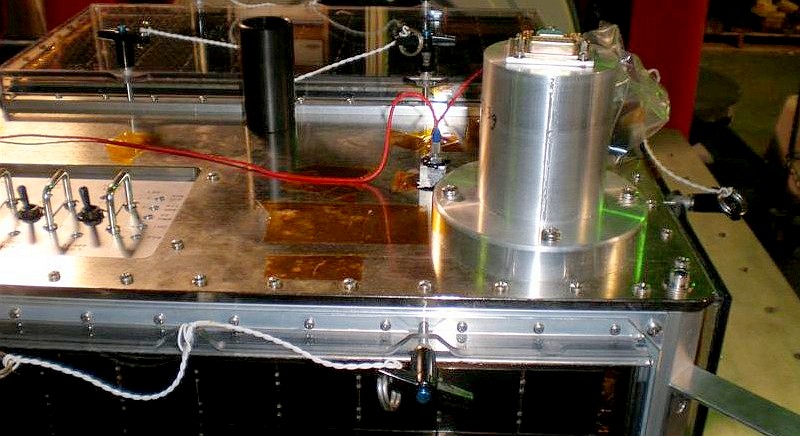
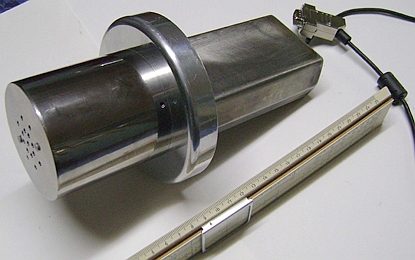
Der Drucksensor wurde von Studenten der Kursk State University in Russland entwickelt und sollte die unterschiedlichen Dichten des Vakuums beim langsamen Absinken in die oberen Schichten der Erdatmosphäre messen. Dazu wird das Experiment für 100 min pro Orbit eingeschaltet um Daten zu sammeln. Im Abstand von wenigen Sekunden werden insgesamt 290 Datensätze (Uhrzeit, Temperatur, Koeffizienten für Strom/Spannungwandler, ADC Verstärkung und Messwerte gesammelt).
Aus all diesen Werten wird ein Strom berechnet, der den atmosphärischen Druck repräsentiert.
Die blaue Kurve zeigt die Temperatur in Grad Celsius an, die rote Kurve repräsentiert den Strom in n*E-10 Ampere. Der daraus resultierende Druck liegt zwischen 0.0001 und 0.0007 mPascal. Die aktuellen KURSK Experiment Daten zeigen seit dem 12. August konstant MET Wert von 944. Auch die abgespeicherten Telemetriedaten ändern sich nicht mehr und zeigen obiges Muster. Der interne Zeitstempel verändert sich, ist aber ungültig.

Transponder
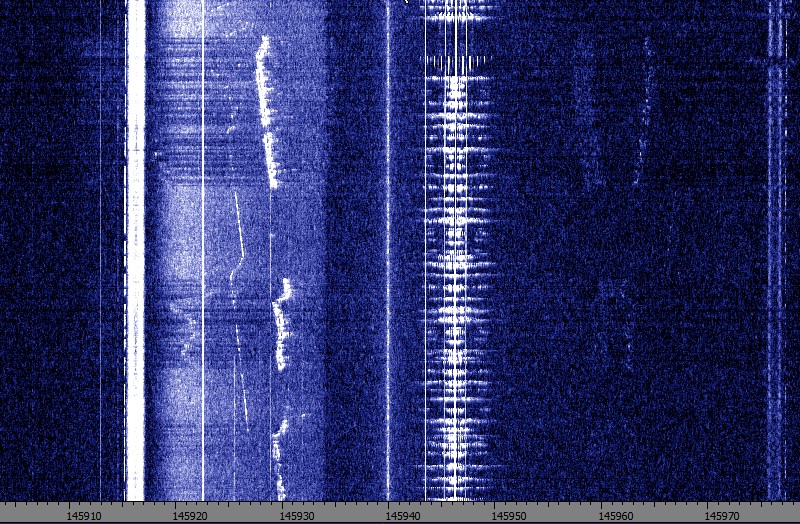
Trotz der nicht mehr vorhandenen 70cm Antenne ist es möglich, den Transponder zu benutzen. Viele Stationen weltweit haben über erfolgreiche QSO’s und sogar SSTV Experimente über den Lineartransponder berichtet.
Hier ist eine exakte Dopplerkorrektur unbedingt notwendig, sonst läuft man quer durch das nur 16 KHz breite Transponderband. erstes QSO zwischen 2 spanischen Stationen (EA1BYC und EA1JM)
erstes QSO zwischen 2 spanischen Stationen (EA1BYC und EA1JM)
thanks Fran, EA1JM for the audio file; orbit #180 on 15-08-2011 at 20:07 UTC CQ satellite M0SAT
CQ satellite M0SAT
Telemetrie und Dekodersoftware
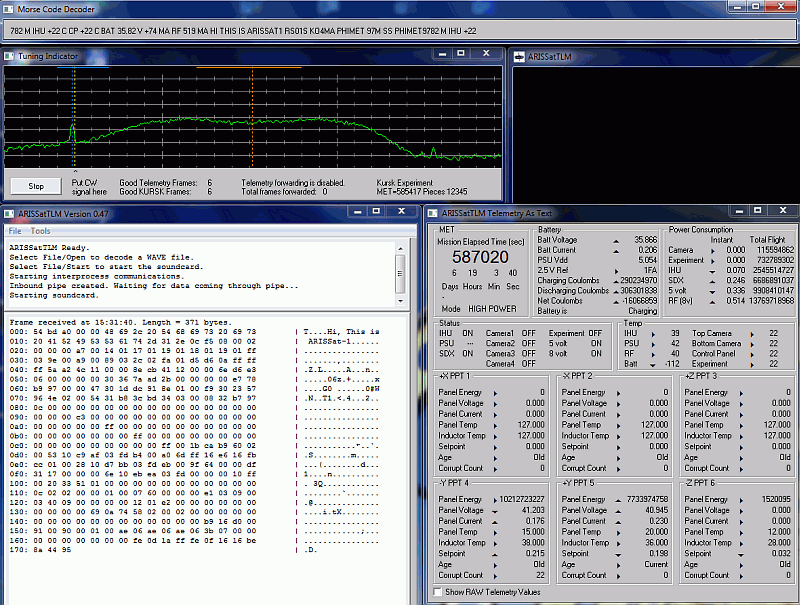
Download der neusten Telemetriesoftware [SUITSAT2] ARISSatTLM/releases
Testtransmission Voice Messages and SSTV – 11.02.2011
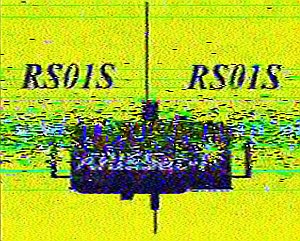
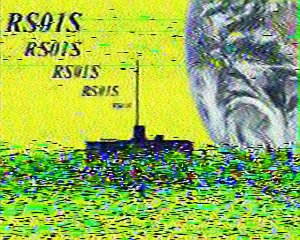
SSTV Bilder von 00:18 UTC und 01:54 UTC am 11.02.2011 ARISSat Voice telemetry
ARISSat Voice telemetry
Historie
ARISSat-1 hat Ende September 2010 den Vibrationstest erfolgreich bestanden. Er soll nun bald nach Russland zur Vorbereitung auf seinen Start geschickt werden. Verlaufen die Vorbereitungen nach Plan, könnte er im Januar 2011 zur Internationalen Raumstation ISS gebracht, um dann im Februar während eines Außenbordeinsatzes ausgesetzt zu werden. Die Amateurfunkausstattung von ARISSat-1 ist reichhaltig: Der Satellit kann für simultane 2-m-FM-, CW- und BPSK-Transpondersendungen genutzt werden. Möglich wird das durch einen Software definierten Transponder. Die FM-Sendungen wiederholen zyklisch eine Sprachansage, ausgewählte Telemetriedaten, 24 internationale Grußbotschaften in 15 Sprachen und Live-SSTV-Bilder. Die BPSK-Sendungen erfolgen in einem von Phil Karn, KA9Q, entwickelten Protokoll, welche die Lesbarkeit auch bei schwachen Signalpegeln ermöglichen sollen. Eine freie Software zur Signal-Demodulation für die Soundkarte soll vor dem Start zur Verfügung stehen. Weiterhin ist ein 16 kHz breiter Transponder für den U/V-Modus vorgesehen. Zum Laden der Batterien sind sechs Solarpaneele vorgesehen. Bei fortgeschrittener Entladung soll ARISSat-1 weiterhin Daten mit geringer Sendeleistung senden, sofern der Satellit genug Sonnenlicht erhält. ARISSat-1 ist der Nachfolger von Suitsat. Letzerer war in einem ausgedienten Raumanzug untergebracht und wurde am 3. Februar 2006 ausgesetzt. Einige Monate später verglühte er in der Erdatmosphäre. Ursprünglich sollte Suitsat-2 bzw. heute ARISSat-1 ebenfalls in einem ausgemusterten Raumanzug installiert werden. Wegen Platzmangel wurde der favorisierte Raumanzug jedoch vorzeitig entsorgt.
The ARISSat-1 satellite, presently still inside the ISS, will be turned on and use an external antenna on 12 April 2011 to celebrate the 50th anniversary of Yuri Gagarin’s first manned space flight.
On Wednesday, 9 Feb 2011 NASA announced that ISS Russian Segment (RS) EVA28 will be broadcast live on NASA TV, starting at 1245 UTC on Wednesday, 16 FEB 11. Included in the schedule for RS EVA28 posted by NASA was the deployment of ARISSat-1/RadioSkaf-V/Kedr RS EVA 28 is being managed by RSC-Energia, the operating entity of the ISS RS, as well as the Soyuz and Progress vehicles.
On Thursday, 10 Feb 2011 RSC-Energia finalized plans to perform a preliminary test of ARISSat-1 while inside the ISS to verify that the satellite could transmit following its delivery to the ISS on a Progress resupply vehicle.
This was not an event that was previously scheduled. Instructions were sent to the Cosmonauts to give them a test procedure with activation scheduled for that day at 1605 UTC. For this test, the ARISSat-1 VHF antenna port was connected to an RF patch panel inside of the Zvezda Service Module, to provide an RF connection of the satellite to one of the four ARISS external antennas mounted on the aft end of the Service Module. ARISSat-1 was then activated and the Cosmonauts listened for the satellite’s FM transmissions using the Kenwood TM-D700(E). This radio is normally used for ARISS school contacts which is connected to an adjacent ARISS external antenna.
AMSAT learned on Friday morning, 11 FEB 2011 that the deployment of the ARISSat-1 satellite had been removed from the RSA EVA 28 timeline by RSC-Energia management. NASA was informed that the ARISSat-1 deployment would be deferred to a later RS EVA, due to changes in the tasks associated with the configuration of RS pay- loads to be performed during RS EVA 28. Subsequently, RSC-Energia informed NASA that deployment of ARISSat-1 will be added to RSC EVA 29 currently scheduled for July 2011.
12. April 2011 – Yuri’s Day
Zur Erinnerung an den 50. Jahrestag des ersten bemannten Raumflugs von Juri Gagarin wird ARISSat-1 aktiviert. Der Satellit befindet sich ja noch an Bord der ISS und wird an eine 2m-Außenantenne angeschlossen. Da ARISSat kein Sonnenlicht erhält, ist er nur im Power-Safe-Mode aktiv. Das bedeutet 40 – 60 Sekunden ON und 2 Minuten OFF. Die Aussendungen beginnen am 11. April 2011 um 14:30 UTC und enden am 13. April 10:30 UTC. Neben Telemetrie und den untenstehenden Soundsamples ist vor allem auch die Stimme Juri Gagarins zu hören.
Wir als Europäer haben diesmal recht ungünstige Durchgänge. Also werden wohl bei uns nur Nachtaktive und Frühaufsteher eine Gelegenheit haben, die Aussendungen live zu hören.
11.04.2011 ISS 21:04 - 21:07 UTC 11.04.2011 ISS 22:36 - 22:44 UTC 12.04.2011 ISS 00:10 - 00:20 UTC 12.04.2011 ISS 01:45 - 01:55 UTC sichtbar mag -1.1 (hell) 12.04.2011 ISS 03:21 - 03:30 UTC sichtbar mag -3.6 (extrem hell) 12.04.2011 ISS 04:56 - 05:03 UTC 12.04.2011 ISS 21:27 - 21:35 UTC 12.04.2011 ISS 23:01 - 23:10 UTC 13.04.2011 ISS 00:36 - 00:46 UTC 13.04.2011 ISS 02:12 - 02:21 UTC sichtbar mag -2.4 (sehr hell) 13.04.2011 ISS 03:47 - 03:55 UTC sichtbar mag -2.5 (sehr hell) 13.04.2011 ISS 05:24 - 05:26 UTC
Allerdings haben wir dadurch den Vorteil, dass wir die ISS dann sehen UND hören können 🙂

Um die gesamte Bandbreite optimal abzudecken verwende ich dieses Setup
Homepage und weitere Informationen
http://arissat1.org/http://www.ariss-eu.org/arissat-1.htm
